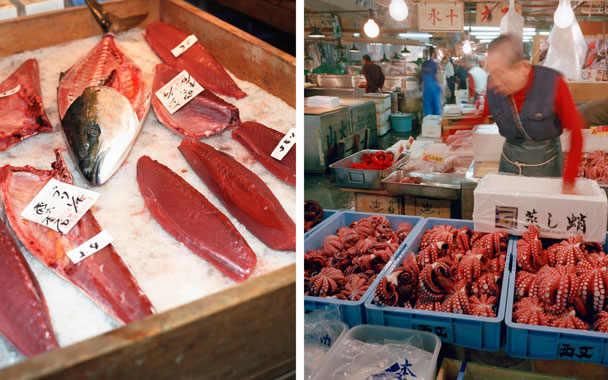Lying awake with jet lag in a Tokyo apartment at 5 A.M., I realized this was the perfect chance to visit Tsukiji, the world’s largest fish market, which was just a subway ride away. The early-morning auctions were already over, but the place would be bustling and the sushi houses nearby gearing up. Rousing my mother and her friend, we threw back our coffee and headed off into the pre-dawn night.
We were in Japan to visit cousins and aunts, a trip we make every decade or so, though I hadn’t been back since the late 1980s. I had visited Tsukiji then, but didn’t recall much except the chaotic hustle and the mountains of fish.
Walking the several blocks from the subway station to the market, past a sashimi-knife store and a noodle-soup vendor, was like was like entering an alternate universe of artisan shops against the more usual backdrop of convenience-store Tokyo.
Once into the narrow aisles of the market, we managed to make headway between the octopus and oysters, the salmon and snapper. These mid-level wholesalers had snapped up fish at the auctions earlier in the morning and now were reselling them to chefs or housewives eager for the freshest fish at the best prices.
We’d planned to browse and not to buy, but temptation proved too great and we decided to pick up the evening’s dinner. At a tuna stand, we bought some chu toro, a medium-fatty cut that I prefer to toro. I wanted to avoid over-fished bluefin, though it was impossible to tell what we were buying: My mother’s fluent Japanese faltered when it came to translating the name of the fish. I was later told that given the amount we spent— 4,000 yen (about $40) for two large fillets—it was unlikely we had bought bluefin, which would have been far pricier.
Nearby, fishmongers cut open tuna carcasses with giant six-foot knives, separating fillet from bone, while others ran frozen fish through circulating band saws. Buckets below collected the fish dust, presumably to be sold as scrap, alongside the piles of fish heads lying around on tables.
We moved from stall to stall, picking up my mother’s favorite tiny black clams, shijimi, and ikura (salmon roe, probably Alaskan); in the myriad stores outside Tsukiji, we bought fresh wasabi root, takuan (pickled white radish), cucumbers, and narazuke (melon pickled in sake brine) from large open vats. Nearby stores specialized in bonito—the dried fish that flavors the most basic Japanese stock, dashi—sold in hunks that looked like wedges of wood.
Back in the fish market, my mom bargained down the price for a small box of uni (sea urchin roe). When the deal was struck, we asked where we should eat sushi, since there were several restaurants within Tsukiji.
The uni man pulled out his cell phone, made a call, and said, “Let’s go, they have three seats!” He led us through the maze of the market at a fast clip—my mother and her friend struggling to keep up, dodging the carts and trucks—and finally ended up at Okame, a sushi house with maybe 10 seats. Once there, the uni man bid us farewell.



 Pinterest
Pinterest


